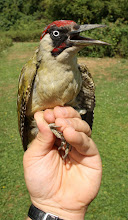Above: A male Siskin
Above: A female Siskin
There are three factors here, a) the weather conditions must have been right, b) natural food sources could be dwindling and c) they are starting to put on weight for migration. Probably a combination of all three, but which has the greater bearing?
Evidence collected during ringing activities showed that the Siskins aren't storing fat ready for long distance migration (yet - therefore 2 factors are left). I can only make an educated guess that the longer winter goes on, the fewer natural food sources there are (in this case Alder seeds) and that today's weather conditions (on the colder side due to wind chill) meant they wanted an extra food supply (i.e. the nyger seed I provide or in this case my brother provided in the form of a christmas/birthday present).
Totals for today (retraps in brackets): 45 birds of 6 species:
Blue Tit 6 (1)
Great Tit 3 (1)
Chaffinch 1
Long Tailed Tit 16
Goldfinch 2
Siskin 15
I haven't been very successful with Long Tailed Tits over the same period - they moved through the netting area during Autumn but then stopped only to move through today. Interestingly, the two flocks that moved through today did not have any rings on them so are presumably different flocks to those that came through during Autumn. Does that mean that the post breeding but pre-dispersal flocks have moved elsewhere and new flocks have entered the territory?
Flocks of Long Tailed Tits have certainly been around in the intervening period but I have not seen them in the immediate netting area or caught any. Answers on a postcard please! Preferably from the current location of previously ringed Long Tailed Tits and c/o BTO!
Also noted today was the lack of retrap Blue and Great Tits (only 1 each) - where do the new birds keep coming from and where are the old ones? Natural dispersal, feeders elsewhere locally, bad/good weather?
One thing is for sure, with the milder weather we are experiencing, the feeders are taking longer to become empty!

